The Road to Digital Transformation: Roles and Requirements for Organizational Success
A panel of pharma digital leaders discusses pathways for technology and data scale-up—and the skills, mindset, and C-suite influence needed to drive true digital transformation.
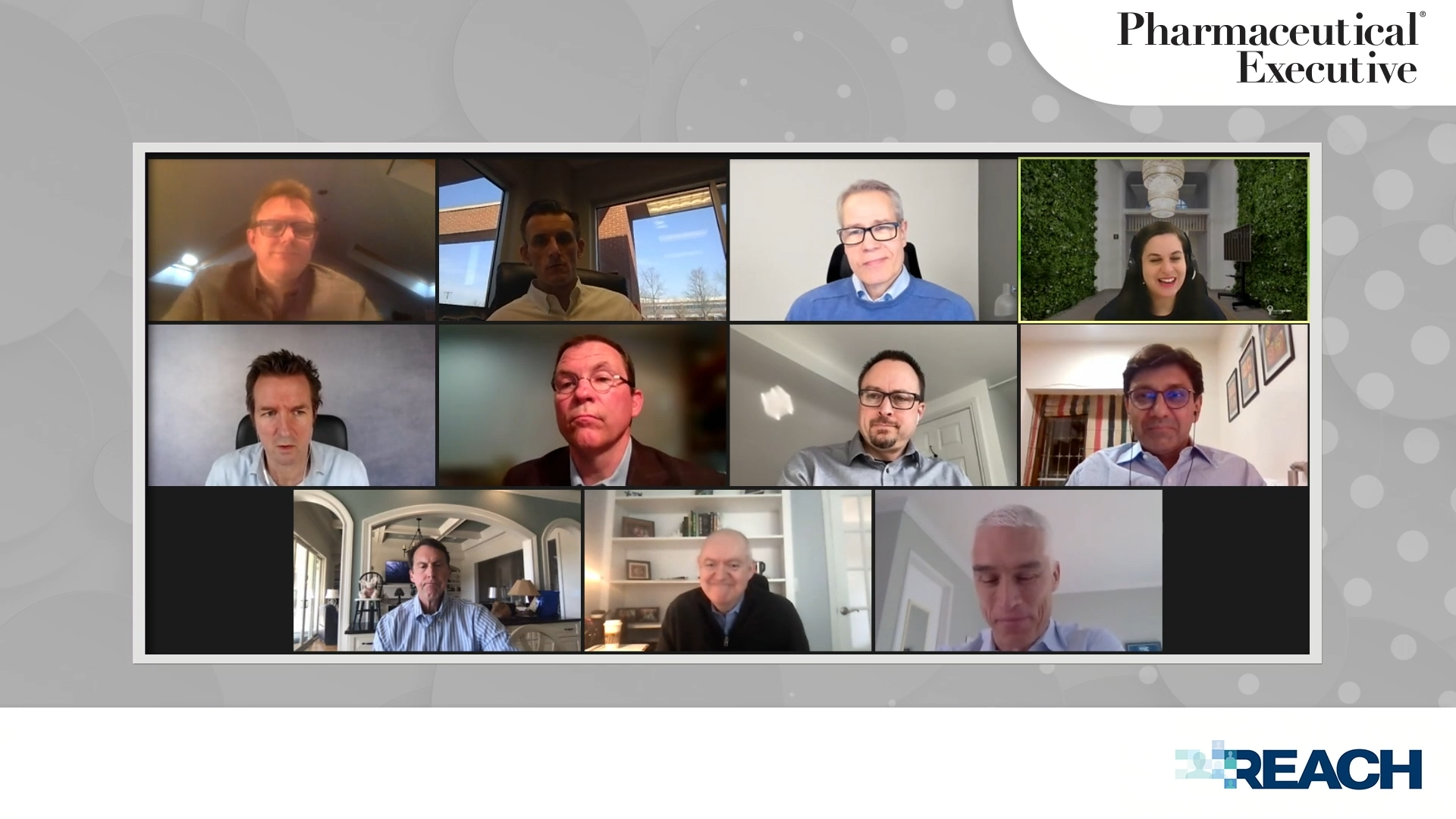
In March 2021, eight biopharma executives joined Pharmaceutical Executive to discuss digital transformation in the industry. Welcoming the panel to the virtual roundtable, Michael J. Hennessy Jr., president and CEO of MJH Life Sciences, parent company of Pharmaceutical Executive, said that while the COVID crisis of the last 12 months has seen the acceleration of digital transformation for many organizations, there are still those that continue to be challenged and are unsure of what to expect going forward.

Moderated by Olivier Leclerc, senior partner at McKinsey & Company, who in recent years led the firm’s digital analytics practice in pharma/biotech, the roundtable drew on expert insights from a panel composed of pharma chief digital officers, chief information officers, and other leaders in the digital space to explore three broad themes: 1) how to scale an organization’s digital transformation; 2) the capability and talent required to support that digital transformation; and 3) defining and optimizing the role of the chief digital officer (CDO). Presented here are highlights of the discussion. View video excerpts from this roundtable.
Olivier Leclerc:What would you say are barriers to scaling up digital and analytics transformation in your organizations, and how do you see them being potentially overcome in the next few years?
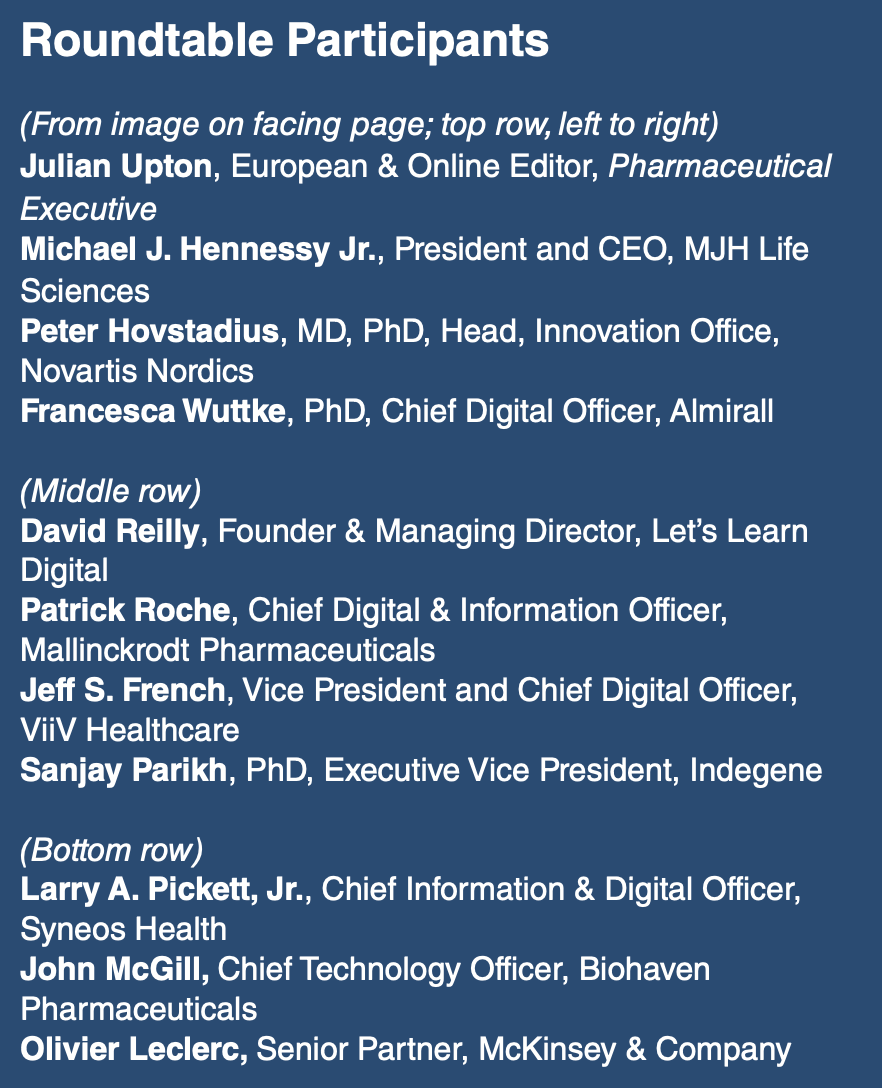
Francesca Wuttke: I think one of the greatest barriers is the way pharmaceutical companies are structured themselves. We have a lot of domain expertise, but working beyond those silos and across various parts of the organization is somewhat challenging. The notion that “This is the way I’ve been doing it all my life” is quite endemic. There’s certainly a degree of risk aversion in trying new things through the implementation of digital solutions, whether it’s clinical trials or a commercial launch or a discovery project. It’s changing certainly, and what we’re seeing in terms of the degree of collaboration between biotechs and pharmas and startups is improving. But we’re late to the game compared with other, perhaps more innovative industries.
David Reilly: I work with a lot of other industries and to me two things are really clear—culture and mindset. The groups I train within the pharma industry are often bruised by the regulatory restrictions and affected by their mindset. My solution would be to look outside of pharma and see how other industries have faced similar problems in their history and try and adopt those mindsets and cultural facets that enable change.
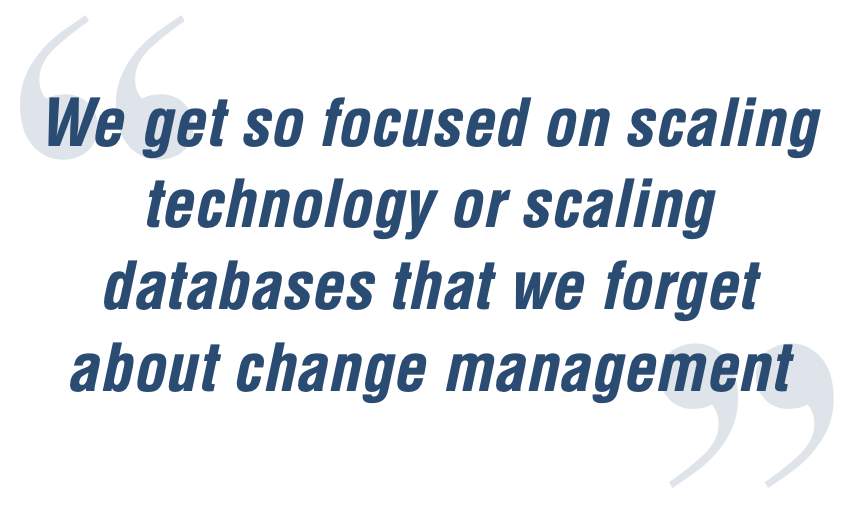
Peter Hovstadius: Many of the barriers to scaling data and digital have to do with basic leadership skills. Sometimes we forget about that when we talk about digital. We get so focused on scaling technology or scaling databases that we forget about change management. Dr. John Kotter’s book Leading Change, I find, is applicable in many pharma situations such as scaling data and digital. Kotter outlined eight pitfalls that any change management could fall into. Briefly, they are, 1) not establishing a great enough sense of urgency; 2) failing to create the sufficient powerful guiding coalition; 3) underestimating the power of vision; 4) under-communicating the vision; 5) permitting obstacles to block the vision; 6) failing to create short-term wins (one of the things that I see again and again is that we’re trying to boil the sea, trying to do too much too soon. We should start with some very successful smaller wins); 7), declaring victory too soon (it’s an inherent thing with data and digital that you need to be able to fail); and, finally, 8) neglecting to anchor changes firmly in the corporate culture.
Leclerc: What do we see happening on the positive side of things?

Sanjay Parikh: One of the positives, looking back as a service provider in this industry, is that about eight or nine years ago, whenever you talked about digital, it was always something “cool” to do. Brand teams were essentially coming up with a digital part in their campaigns just as a check mark. In the last three to four years, however, the whole concept of digital has elevated itself into a boardroom discussion. I think part of that is because of the success of the FAANG [Facebook, Amazon, Apple, Netflix, and Google] companies. Pharma executives have come to realize that.
In terms of disruption, if you look at, say, how Netflix completely disrupted the Blockbuster Video model, I don’t think pharma is going to go through that kind of drastic disruption. It’s going to be a continuous transformation, because you need to carry a lot of that muscle memory of what goes into pharma and embed the right kinds of change catalysts within the organization.
Jeff French: If you think of what’s happened over the past three to four years—how digital has started to infiltrate the various functions of the organization—it goes back to the leadership principle. You’ve got to have progressive leadership that can identify how to bring everything together and communicate the vision clearly enough for the organization to want to change its culture. It should also be measurable. One of the biggest barriers is that you’re constantly being asked to prove the value of what digital has brought to the table. That could relate to really small, incremental-value projects all the way through to complete business model shifts. If you’re not able to provide that, people are going to think you’re failing or not doing it right.
Leclerc: We’ve seen vast differences in the uptake of digital analytics by function or domain. Leadership is certainly one of the factors to consider here. But which other factors do you think are at play in explaining why some functions adopt faster than others?
John McGill: It really comes down to business imperative. That can be the differentiator between the functions. In my company, Marketing and Sales, for example, is very aware of the capabilities and value from digital transformation, from predictive analytics and AI, etc. But there are other functions within the company where that awareness is still developing. The trick that I’m tasked with is pulling that all together into a more homogeneous, company-wide transformation ultimately to drive greater value.
Larry Pickett, Jr.: The more innovative departments and the ones more oriented to this are already well down the path. But others may be a little more reluctant. If you’re going to scale it, then you have to strongly communicate we’re doing this. For example, a simple stat I recently shared: In 2019, only 3% of the clinical trials out of 32,000 were digital or hybrid. Cognizant is projecting that over the next four years that will increase to 25%—an increase of more than 800%. It’s clear this is a business imperative that we move ahead with. Getting that message out across the organization from the top down will help some of those groups that may be slower to adopt.
Leclerc: What other factors, such as data maturity, could be important here?
McGill: When I first started at Biohaven, one of the questions I had after the first week was, “Where is our data?” Because it was and still is in a lot of places. And the other questions are, for the data we have, “Is it accessible? Is it clean? Is it what we need? How do we bring it together and drive business value?”
French: Historically, we’ve had this concept where data is owned by a silo, or that different parts of the organization have restricted access to the data. How do we start sharing and leveraging the understanding that other people within the organization have so that we can go forward? It is about opening up the data, federating the data, making it accessible and clear for other people to use. I think we’re just at the crux of that. There’s work to be done in terms of aligning that and getting people to handle the opportunity that their data actually presents.
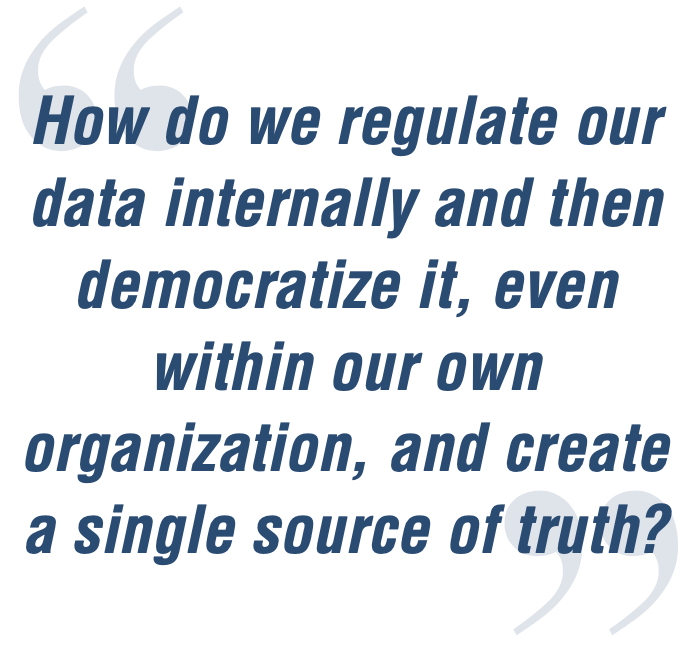
Wuttke: There’s also a big data governance question. How do we regulate our data internally and then democratize it, even within our own organization, and create a single source of truth? In our experience, we’re building this from the ground up. If I look, for example, at how revenue was being captured, it was on a country level and on a brand level. Within the brand level, it could be captured as a calendar month, or from the first Monday to the last Friday of the month. So you get different numbers, and people start to lose faith in those numbers. We have to validate the numbers and put some definitions and rules behind them so that we’re all defining things the same way.
Leclerc: Can you talk about the interplay between the IT function and the rest of the organization? How can IT either be a driver or, in some cases, actually an impediment to digital transformation?

Patrick Roche: Pharma tends to be siloed a bit functionally. Part of that is that the traditional IT organization has built these technology assets and the infrastructure that supports them. There’s been a certain measured speed associated with that kind of traditional, plan-build-run view of IT. The burning platform for pharma is moving faster, and being able to provide meaningful insights from that data and use it to fuel clinical trials and better commercial decision-making. What I’ve experienced is a speed differential in terms of expectations and needs from the business communities and what traditional IT groups have been able to fulfill. What has helped that is starting small and picking an area where there can be very close collaboration.
The burning platform for us was in Commercial because COVID basically closed the doors to a lot of the hospitals and closed entry paths into traditional selling methods. So it created a case for change, which fueled collaboration at a level that hadn’t existed before. That increased the speed and helped break down the silos. You can point to that as a win. You can measure the success and demonstrate it to the rest of the enterprise. That leads to lightbulbs flicking on in other parts of the organization and starts to build that momentum. But it’s got to start with a small area where you can make a difference.

Pickett, Jr.: You hit on a great point, which is the speed of delivery. If we can’t match the speed of Commercial, or whoever’s moving fast, then we have an uphill battle. But it’s not just a case of saying, “Let’s go fast.” You have to have people that know how to go fast.
At a previous company, we brought in talent from the financial services industry. They had worked in advanced analytics for many years ahead of pharma and life sciences. That mindset of speed was on a different scale, because they were doing high-frequency trading and real-time analytics on streaming data. When we told them that they had a week or two to deliver something, they looked at us like we were crazy because on Wall Street you have to get it done straight away. But, of course, the challenge for us in pharma is balancing the speed with making sure you meet all the regulatory requirements.
McGill: I’ve come from companies that have pretty large central IT organizations. At Biohaven, I’m trying to create more of a collaborative network of IT-savvy business professionals and supplementing that with a smaller central organization, which is more focused on strategy and collaboration and enables us to keep a focus on those business imperatives.
Ask me in two years how that’s going, but that’s essentially how we’re approaching it.
Wuttke: There has to be a collaborative approach, but there isn’t a clear definition across the industry about what is digital health, what is digital medicine, what are digital therapeutics, and what’s IT, and how we play nicely in the same sandbox together. It’s great when we do, but it’s not always clear.
The second thing is around timing. As an industry, we’re used to seeing very long development timelines for products. But if you slap the word “digital” on anything, people expect it to be done straight away. There should be a proper assessment of how long things will take realistically if you’re implementing a digital solution.
Parikh: We also have to think of the mindset of the people who are going to consume the insights that are being leveraged. Even now, there’s still a significant amount of skepticism about some of the data-driven insights that come back from the analytics algorithms. That empirical chauvinism, if you will, still continues. The acceptance of data-driven decisions is something that needs to be driven from the top.
Leclerc: Larry, you mentioned how you were importing talent from outside of the industry. We’d love to hear how is that working out and what, in your view, should be a company’s talent strategy in that area?
Pickett, Jr.: It has worked out extremely well. But it’s a long-term investment. If you bring in someone from Wall Street who knows how to do high-frequency trading on stock trades, and that has been their whole career, they then have to learn about patient data and pharmaceutical data and understand the industry. There has to be a training program to bring those individuals up to speed. It’s going to take three to five years to get them to where they really understand it. Not that they can’t be productive in the short term. In my experience, they can bring in new thoughts in terms of tools and technologies that we hadn’t even thought about using in pharma from a speed and capability standpoint.
We also went to the India Institute of Technology and partnered with PhD students who were doing a lot of advanced analytics and machine learning. We taught them about the industry, the data, and when they got their PhDs, a couple of them joined our company and were able to bring that cutting-edge knowledge, the very latest thinking about how to apply advanced analytics to data. Bringing those two fields of knowledge together was very powerful.
Hovstadius: There is the question, though, of how, in a sustainable way, do we staff our companies to keep up the pace of the acceleration around us? Is it through importing special talents or is it finding the people that are extremely curious and agile and willing to learn new things? We need to staff our companies with curious and entrepreneurial people, of course. And you will find people externally that have special skills. But the people coming in with the special skills might actually not be that curious and willing to change once they’re inside. They have the same limitations as we do working in the companies right now.
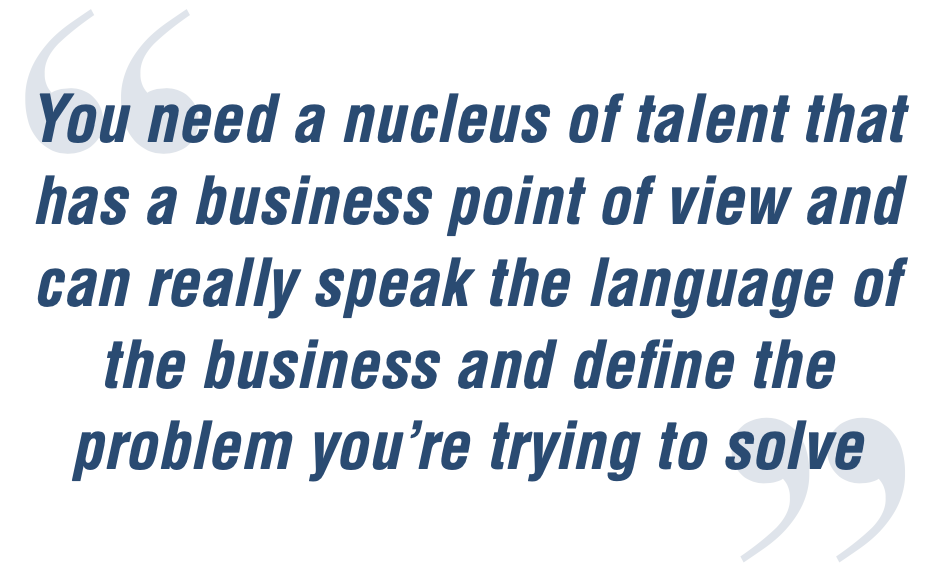
Roche: What I’ve found is that people throw the word “digital” around a lot and they tend to gravitate toward the shiny-object discussions. But, really, digital is about solving business problems with processes, data, and technology. Having people with the capabilities to really embed themselves in and understand the business issues we’re trying to solve is the most important part of this. You need a nucleus of talent that has a business point of view and can really speak the language of the business and define the problem you’re trying to solve.
Reilly: I think curiosity is a vital companion for digital transformation. I’ve seen it in the UK with Novartis really investing in good learning capabilities. They’re embedding this into their organization and they’re using frameworks from tech and IT to make things faster. But there is a caveat because a lot of pharma companies automatically look to big tech and the frameworks, for example, of Amazon. They think, “Okay, we can apply this to our own culture,” and sometimes it doesn’t work.
We have to take the frameworks and see if they work for us; sometimes you find the right people with the right mindset and it does work. But in the longer term, we need to embed this learning all the time, which is a completely different mindset.
That’s a hard challenge, but once it can be embedded into an organization, then innovative solutions can happen.
Leclerc: What is the importance of buying in those capabilities from outside using consulting firms or startups, as opposed to building from inside? Or what should be the balance between the two?
Hovstadius: Truly, it’s a mix. The equilibrium might change a little bit, but it should be somewhere around 80/20. You can externalize in terms of insourcing or outsourcing, but no more than about 20%. On the other hand, taking internal candidates that have talent and giving them the right skills shows them that they are appreciated in the organization and are working toward something.
If we always buy from the outside, it’s going to give the wrong signals, and it’s not going to be sustainable.

Wuttke: I’m very much of the mindset that it’s not worth reinventing the wheel because we won’t be able to do it as well as the people who have done it well and who have experienced all the trials and errors. If we find a solution in the market that works, why wouldn’t we then adapt it, rather than trying to replicate it in-house?
McGill: It’s about getting control of the things that are most important. I use a tremendous amount of external partners, but we’re not losing control of the things that are differentiators for us as a company. Over the last year we have started to pull back some elements of control from partners, but essentially, I’d say we’re the opposite of Peter’s 80/20, with probably 20% internal and 80% external. Let’s not reinvent the wheel, but let’s make sure that for the elements that we think are differentiators for us, that are critical, that we have good control, whether that’s internal or with a special relationship with a partner.
Parikh: What we have found to work extremely successfully with some of our clients is where we co-invest in that innovation. Because for a service provider or a solution provider or a startup, that is their entire business. They are motivated to be ahead of the curve, no matter what.
Leclerc: Finally, how do you define success? What makes a digital officer successful in pharma today, and what are your aspirations going forward?
Pickett, Jr.: It’s all based on focusing on revenue and delivering the business results that we’re looking for in terms of bringing new products to market, being able to accelerate the adoption of those new products in the market, and then increasing the margins. I try to tie everything to the business outcomes that we’re trying to achieve and do that in a very measurable fashion. If we’re able to help drive revenue or bring in new streams of revenue through digital products and digital innovation, or able to increase our margins because we’re more efficient, then to me that’s success at the highest level.

Reilly: I think digital success can be measured by a cultural change. You can see someone who’s infinitely more curious than they were six or 12 months ago just by looking at their language and their curiosity. We need to think about how we can measure a tangible shift in the culture and mindset of our people. But that’s probably another debate in itself.
Hovstadius: I think it’s leadership all the way here, because the chief digital officer or information officer sits in the leadership team. Their colleagues in the leadership team need upskilling, so CDOs need to be very strong in terms of communication to really get people behind them. Their colleagues in the leadership team will then go out to the organization and transmit what they’ve learned and how they’ve been inspired.
Wuttke: For a digital office to be successful, it really has to be embedded across the whole organization. When I was hired, I said, “You know, if I do my job well, I shouldn’t have a job in five years because there shouldn’t be a chief digital officer in the company. There should be people implementing digital initiatives as part of their strategy.”
That’s not a very comforting thought to those of us who have that title, but I do see that as a goal.

French: I think that digital continues to change the game, and if your peer group constantly looks to you to provide context around what’s coming next, that tells me that you’re successfully integrated. You are becoming part of that strategy element of the organization focused on where the business needs to go. If I’m doing that and people are tapping me on the shoulder and saying, “What’s your idea for what this is?” that tells me that they’re not thinking about digital just as a special project but that they are thinking about digital natively.
Parikh: We need to recognize that 10 years from now, the way pharma will take their products to market will have changed. If you started building your pharma company from scratch, you wouldn’t build it the way it is today. You’d fundamentally alter the paradigm, and that means better customer experiences, faster clinical trials, faster time to submission, better management of your supply chain, etc. But I think the chief digital officer would still have a role because he or she will be the key pivot in getting pharma to then connect with the overall healthcare ecosystem, which includes payers and providers.
Who better than the chief digital officer to make that connection? If we truly believe that we’re here for patients, then that needs to happen.
Julian Upton is Pharm Exec’s European and Online Editor. He can be reached at jupton@mjhlifesciences.com.
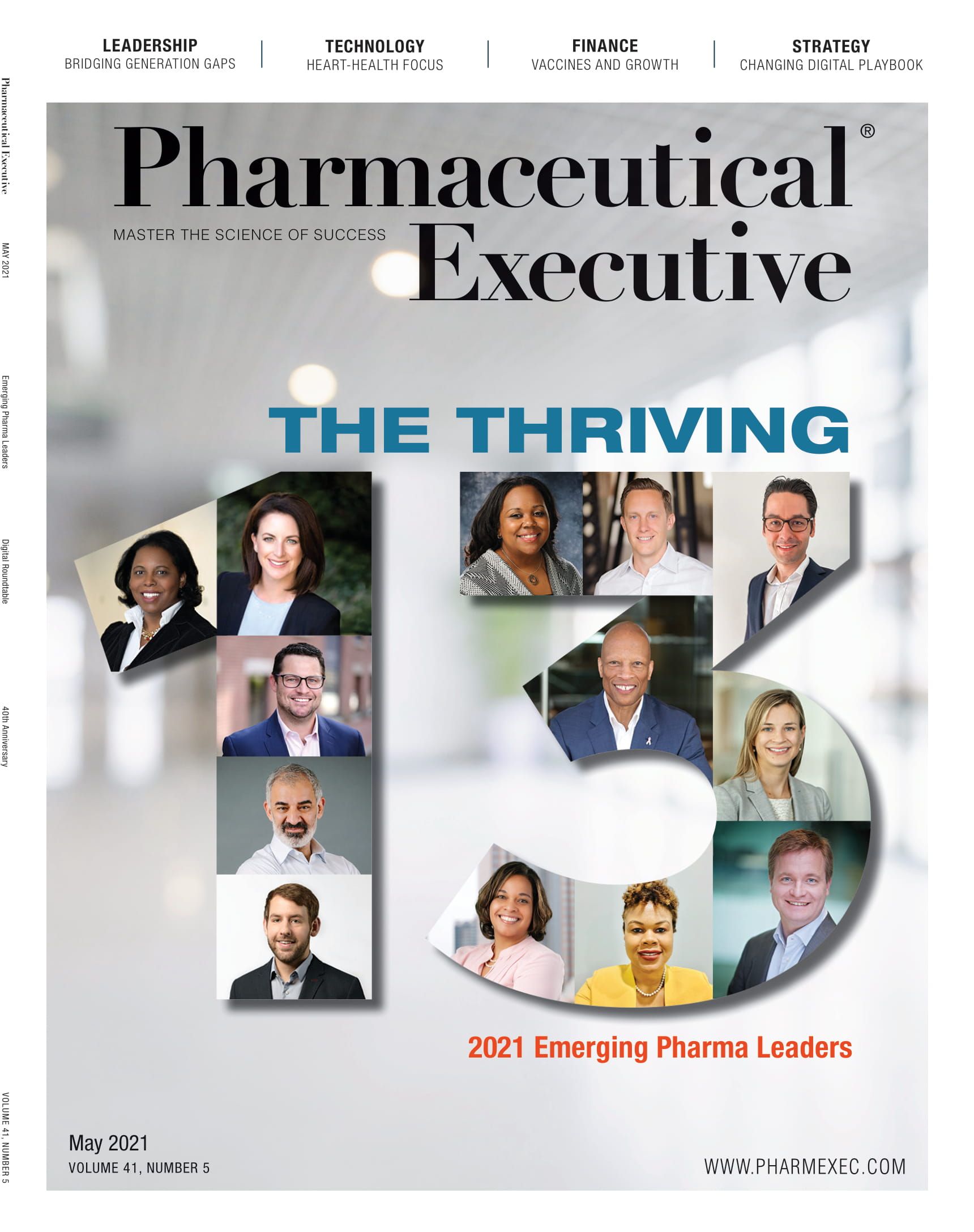
An Evolving ‘Opinion’ Landscape: New Paths—and Synergies—for Pharma KOLs & DOLs
October 13th 2023Industry experts discuss the relationship between digital and traditional (key) opinion leaders and how companies are adjusting their strategies to harness the unique brand engagement benefits each role can provide in driving better patient outcomes.